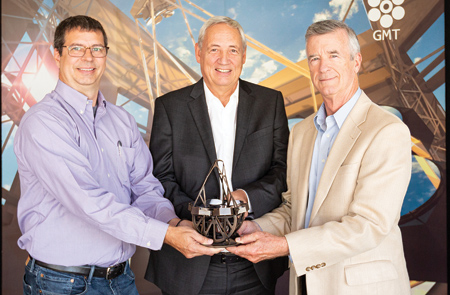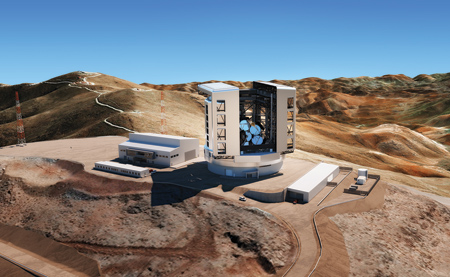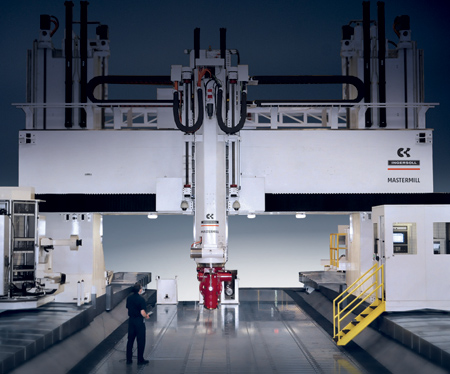
(l-r) Ingersoll Machine Tools CEO Chip Storie, MT Mechatronics Senior Vice President Thomas Zimmerer, and GMTO President Dr. Robert N. Shelton, with a bronze model of the telescope structure.

GMT site rendering


Structure of the GMT. Light from the edge of the universe will first reflect off of the seven primary mirrors, then reflect again off of the seven smaller secondary mirrors, and finally, down through the center primary mirror to the advanced CCD (charge coupled device) imaging cameras. There, the concentrated light will be measured to determine how far away objects are and what they are made of.
GMTO Corporation, the organization managing the development of the Giant Magellan Telescope (GMT) on behalf of its U.S. and international founders, has signed a contract with Ingersoll Machine Tools and MT Mechatronics to design, build and install the telescope's precision steel structure. The GMT is an 80' diameter next-generation giant optical-infrared observatory that will explore the frontiers of astronomy. The GMT will study the atmospheres of planets orbiting stars far from our solar system to search for signs of biochemistry.
MT Mechatronics (Germany) and Rockford, IL-based Ingersoll Machine Tools, part of the Italian Camozzi Group, will design and manufacture the 1,800-ton precision mechanism, known as the "telescope structure," that will hold the GMT's optics and smoothly track celestial targets as they move across the sky. The telescope structure will be designed by MT Mechatronics and manufactured, assembled and tested by Ingersoll before being shipped to, and installed at, the GMT observatory site located high in the remote Chilean Andes.
The total value of the telescope structure contract is $135 million and will require 1,300 tons of structural steel and nine years of effort by a large workforce of engineers, designers, metal workers and machinists. The contract was signed by MT Mechatronics Senior Vice President Thomas Zimmerer, Ingersoll Machine Tools CEO Chip Storie, and GMTO President Dr. Robert N. Shelton and Project Manager Dr. James Fanson.
Lodovico Camozzi, Chairman and CEO of Camozzi Group, stated, "We are delighted that we will be working on the creation of an exclusive scientific and revolutionary system for studying the deep cosmos." Chip Storie, CEO of Ingersoll Machine Tools, added, "It will be a special day when the GMT telescope structure is completed and placed in service in Chile, as part of one of the most complicated and fascinating projects that the world scientific community has ever undertaken."
"Manufacturing the telescope structure is one of the biggest steps we will take on our journey to building the Giant Magellan Telescope," said Dr. Shelton.
"We selected Ingersoll Machine Tools and MT Mechatronics for their commitment to quality, extensive experience with astronomical telescopes and abilities to manufacture complex precision structures, following a two-year global competition," added Dr. James Fanson, GMTO Project Manager.
The Giant Magellan Telescope
The GMT is an 80' diameter next-generation giant optical-infrared observatory. The telescope's primary mirror combines seven 27' diameter circular segments to form an effective aperture 80' in diameter. The mirrors, the largest in the world, are made at the University of Arizona's Richard F. Caris Mirror Lab.
The telescope structure will hold the GMT's seven giant mirrors in place as they bring light from distant stars and galaxies to a focus so it can be analyzed by scientific instruments mounted deep inside the telescope. When in operation, the telescope structure, complete with mirrors and instruments, will weigh 2,100 tons but will float on a film of oil just 50 microns (2 one-thousandths of an inch) thick-allowing it to move essentially without friction as it compensates for Earth's rotation, tracking celestial bodies in their arc across the sky. This hydrostatic technology was patented by INNSE, a Camozzi Group company. The GMT will produce images that are 10 times sharper than those from the Hubble Space Telescope in the infrared region of the spectrum.
The GMT will be located at Las Campanas Observatory in Chile's Atacama Desert. The project is the work of a distinguished international consortium of leading universities and science institutions. Funding for the project comes from the partner institutions, governments and private donors.
GMTO manages the GMT project on behalf of its international founders: Arizona State University, Astronomy Australia Ltd., The Australian National University, Carnegie Institution for Science, Fundaçao de Amparo à Pesquisa do Estado de Sao Paulo, Harvard University, Korea Astronomy and Space Science Institute, Smithsonian Institution, Texas A&M University, The University of Arizona, The University of Chicago and The University of Texas at Austin.
The Camozzi Group (Italy) produces components and systems for industrial automation in a variety of sectors and provides solutions involving the processing of raw materials.
Ingersoll Machine Tools (IMT) is a global provider of advanced machine tools for the aerospace, transportation, energy and heavy industries.
MT Mechatronics (Germany) provides global services as prime contractor for design, development, system integration, commissioning, training, maintenance and operations for communication and deep space antennas, radio and optical telescopes, mechatronic equipment for research institutions, launching facilities for the European space program and large medical systems for the next generation of particle cancer therapies.
For more information contact:
Ingersoll Milling Machines
707 Fulton Ave.
Rockford, IL 61103
815-987-6000
info@ingersoll.com
www.ingersoll.com
Camozzi Group
www.camozzi.com
GMTO Corporation
www.gmto.org